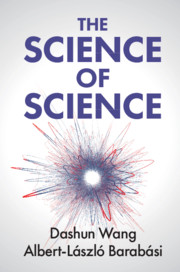Book contents
- The Science of Science
- The Science of Science
- Copyright page
- Dedication
- Contents
- Acknowledgements
- Introduction
- Part I The Science of Career
- Part II The Science of Collaboration
- Part III The Science of Impact
- 15 Big Science
- 16 Citation Disparity
- 17 High-Impact Papers
- 18 Scientific Impact
- 19 The Time Dimension of Science
- 20 Ultimate Impact
- Part IV Outlook
- Book part
- References
- Index
18 - Scientific Impact
from Part III - The Science of Impact
Published online by Cambridge University Press: 07 February 2021
- The Science of Science
- The Science of Science
- Copyright page
- Dedication
- Contents
- Acknowledgements
- Introduction
- Part I The Science of Career
- Part II The Science of Collaboration
- Part III The Science of Impact
- 15 Big Science
- 16 Citation Disparity
- 17 High-Impact Papers
- 18 Scientific Impact
- 19 The Time Dimension of Science
- 20 Ultimate Impact
- Part IV Outlook
- Book part
- References
- Index
Summary
Here, we focus on two factors that contribute to a paper’s fitness: novelty and publicity. By measuring the novelty of the ideas shared in a paper, we can explore the link between the originality of the research and its impact. Since new ideas are typically snythesized from existing knowledge, we can assess the novelty of an idea by looking at the number domains from which researchers sourced their ideas and how expected or unexpected the combination of domains are. Evidence shows that rare combinations in scientific publications or inventions are associated with high impact. Yet novel ideas are riskier than conventional ones, frequently resulting in failure. Research indicates that scientists tend to be biased against novelty, making unconventional work more difficult to get off the ground. In order to mitigate risk while maximizing novelty, scientists must balance novelty with conventionality. We then look at the role that publicity plays in amplifying a paper’s impact. We find that publicity, whether good or bad, always boosts a paper’s citation counts, indicating that, even in science, it’s better to receive negative attention than no attention at all.
Keywords
- Type
- Chapter
- Information
- The Science of Science , pp. 189 - 196Publisher: Cambridge University PressPrint publication year: 2021



